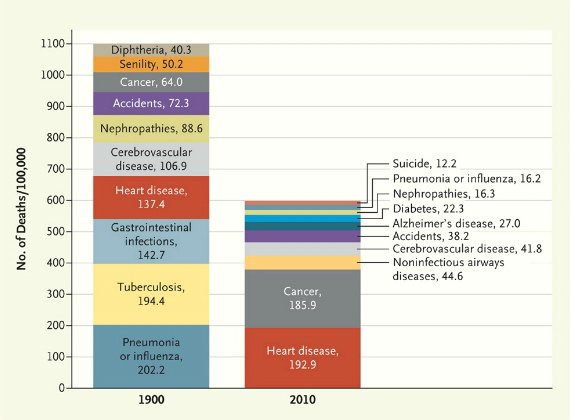The Other Harm Caused by Mitochondrial DNA Damage in Aging
As I'm sure you all know by now, mitochondria are swarming powerplants within the cell, descendants of symbiotic bacteria that bear their own DNA separate from the DNA in the cell nucleus. Mitochondrial DNA provides the blueprints for proteins making up the machinery of a mitochondrion, but it isn't as well protected or as well repaired as nuclear DNA. Given that a lot of reactive compounds are funneled through mitochondria in the processes that keep a cell powered, it is only to be expected that mitochondrial DNA becomes progressively more damaged over time. The range of mechanisms that have evolved to deal with that damage cannot keep up over the long term, and as a result a small but significant portion of our cells fall into ruin on the way to old age, becoming populated by dysfunctional, damaged mitochondria, and causing a great deal of harm to surround tissues and bodily systems by exporting a flood of reactive biochemicals. You can read a longer and more detailed description of this process back in the Fight Aging! archives.
So that is one side of the issue of mitochondrial DNA damage and its contribution to degenerative aging - and that in and of itself would be more than enough to make mitochondrial repair biotechnologies a research priority. There are many different potential ways of fixing or rendering irrelevant mitochondrial DNA damage, and allowing mitochondria to continue to function as well as they did at birth for an indefinite period of time. The sooner one of them is developed into a working therapy the better.
In considering mitochondrial damage there is another, more straightforward process at work, however. Many types of cell normally operate fairly close to the limit of the power provided by their mitochondria, including important cell populations in the brain and nervous system. As mitochondrial DNA damage accumulates with age, power production - meaning the pace at which adenosine triphosphate (ATP) is produced - falls off and cells either die or malfunction far more often than they did in youth. This is outlined in a recent open access review paper:
In aerobic cells the majority of ATP is produced by oxidative phosphorylation. This process takes place in the mitochondria where electrons that are donated from the Krebs cycle are passed through the four complexes (complex I-IV) comprising the electron transport chain (ETC), eventually reducing oxygen and producing water....
Many cells operate at a basal level that only requires a part of their total bioenergetic capability. The difference between ATP produced by oxidative phosphorylation at basal and that at maximal activity is termed "spare respiratory capacity" or "reserve respiratory capacity" ... Under certain conditions a tissue can require a sudden burst of additional cellular energy in response to stress or increased workload. If the reserve respiratory capacity of the cells is not sufficient to provide the required ATP affected cells risk being driven into senescence or cell death.
...
In this paper we hypothesize that mitochondria contributes to aging and age-related pathologies through a life-long continued decrease of the respiratory reserve capacity. The decrease sensitizes high energy requiring tissues to an exhaustion of the reserve respiratory capacity. This increases the risk of a range of pathologies that correspondingly are known to be age-related. Through a review of the effects of aging on the regulation of oxidative phosphorylation, we wish to substantiate this hypothesis. In addition, by using brain, heart, and skeletal muscle as examples, we will review how an age-related decrease of the reserve respiratory capacity is implicated in a variety of pathologies in the affected tissues.
Interestingly, there is a good case for arguing that it isn't just damage to mitochondria DNA (mtDNA) that reduces levels of power production in a cell's mitochondria - there are other changes taking place that turn down the dial, which in the absence of more definitive knowledge as to their causes could be classified either as programmed aging or as a programmed response to stochastic damage in other cellular systems:
Cumulative damage to the mtDNA is however, not the only contributor to the age-related decline of oxidative phosphorylation. Transcriptional profiling has revealed different regulation of nuclear genes encoding important peptides for oxidative phosphorylation when comparing young to old.
Either way, those mitochondria still need fixing. The biotechnologies capable of that job are on the horizon, and would be coming closer more rapidly if those involved in the work had a greater level of funding.
